Our Schools
Table of Contents
Reading is an essential skill that children need to acquire, as it sets the foundation for their academic and personal growth. Books and reading can have a profound impact on a child’s cognitive, emotional, and social development. In this article, we will explore the many benefits of reading and why it is so crucial for kids. We will also take a closer look at how Ekya Schools, one of the best CBSE and ICSE schools in Bangalore, encourages and promotes reading among its students.
The Importance of Reading
Reading is an excellent way to stimulate the mind and improve cognitive skills. When children read, they are exposed to new words, phrases, and ideas that they may not encounter in their daily lives. Being exposed to a wide variety of literature can aid in expanding a child’s lexicon, augmenting their comprehension capabilities, and honing their critical thinking aptitude. Reading also helps children develop their imagination and creativity as they imagine the scenes, characters, and events in the stories they read.
Books Reading: A Source of Knowledge
Books are a source of knowledge and information, and reading them is an essential part of a child’s education. Reading books exposes children to a wealth of information on different subjects, from history to science to literature. This knowledge broadens their horizons and helps them better understand the world around them. Moreover, books offer different perspectives and viewpoints, which can help children develop empathy and understanding towards others.
The Benefits of Reading Books for Students
Reading books has several benefits for students. It improves their academic performance by enhancing their vocabulary, comprehension, and critical thinking skills. It also helps them develop good study habits and discipline, which can be useful in their academic and personal lives. Reading books can also improve their writing skills as they learn how to express their thoughts and ideas more effectively.
Reading as a Form of Entertainment
Reading is not just an educational activity; it can also be a form of entertainment. Reading books can be a fun and enjoyable activity that children can do in their free time. It can be a way to escape into different worlds and experiences, which can be especially important during times of stress or anxiety. Reading can also be a social activity, as children can share books with their friends and family and discuss their favorite stories and characters.
Ekya Schools’ Approach to Reading
At Ekya Schools, we understand the importance of reading and its benefits for our students. We encourage and promote reading in various ways, such as through our well-stocked libraries, reading clubs, and literary events. Our libraries are equipped with a vast collection of books on different subjects and genres, catering to the diverse interests and reading levels of our students. We also organize reading clubs, where students can discuss and share their favorite books and authors with their peers. Additionally, we hold literary events such as book fairs, author visits, and storytelling sessions, which further foster a love of reading among our students.
Conclusion
In conclusion, reading is a vital activity that children should engage in regularly. It has numerous benefits for their cognitive, emotional, and social development and can significantly impact their academic and personal growth. At Ekya Schools, we recognise the importance of reading and strive to cultivate a love of books and reading among our students. By promoting reading and providing them with a rich and diverse collection of books, we aim to create lifelong learners who are knowledgeable, curious, and creative.
56 Names of Shapes with Pictures
Why Teaching Shapes is Crucial for Early Childhood Development?
 Shapes are all around us, and teaching shapes is essential for several reasons. Here are some of the reasons why teaching shapes is so important:
Developing Spatial Awareness:
Shapes are all around us, and teaching shapes is essential for several reasons. Here are some of the reasons why teaching shapes is so important:
Developing Spatial Awareness:
 Shapes are the foundation for spatial awareness, which is the ability to understand and navigate the physical world around us. By learning shapes, children develop spatial skills that help them understand how objects relate to one another in space. This is a critical skill that helps children navigate their environment, solve problems, and succeed in math and science.
Improving Visual Perception:
Shapes are the foundation for spatial awareness, which is the ability to understand and navigate the physical world around us. By learning shapes, children develop spatial skills that help them understand how objects relate to one another in space. This is a critical skill that helps children navigate their environment, solve problems, and succeed in math and science.
Improving Visual Perception:
 Identifying shapes requires visual perception skills, which are essential for reading, writing, and many other activities. By learning to identify and distinguish shapes, children improve their visual perception skills, which helps them learn to recognize letters, numbers, and other symbols.
Enhancing Cognitive Development:
Identifying shapes requires visual perception skills, which are essential for reading, writing, and many other activities. By learning to identify and distinguish shapes, children improve their visual perception skills, which helps them learn to recognize letters, numbers, and other symbols.
Enhancing Cognitive Development:
 Learning shapes also helps children develop their cognitive skills, including memory, attention, and problem-solving. By recognizing shapes, children learn to categorize objects based on their properties, which enhances their ability to think logically and critically.
Preparing for Math:
Learning shapes also helps children develop their cognitive skills, including memory, attention, and problem-solving. By recognizing shapes, children learn to categorize objects based on their properties, which enhances their ability to think logically and critically.
Preparing for Math:
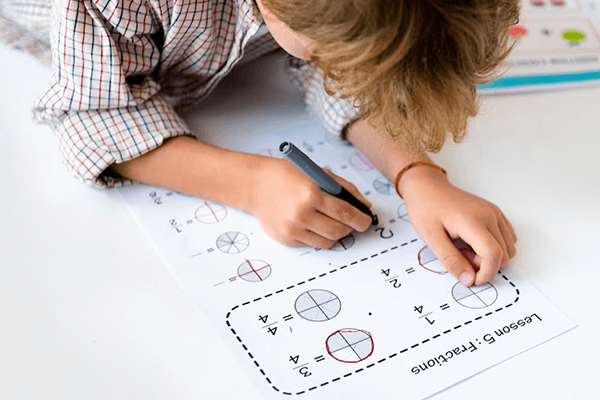 Shapes are an essential part of math, and understanding shapes is crucial for success in math. By learning shapes, children develop a foundation for understanding geometry and other mathematical concepts. They also learn to calculate the area, perimeter, and volume of shapes, which are fundamental skills for solving math problems.
Boosting Creativity:
Shapes are an essential part of math, and understanding shapes is crucial for success in math. By learning shapes, children develop a foundation for understanding geometry and other mathematical concepts. They also learn to calculate the area, perimeter, and volume of shapes, which are fundamental skills for solving math problems.
Boosting Creativity:
 Shapes are a fundamental component of art and design. By learning shapes, children develop their creativity and imagination. They learn to identify shapes in the world around them and use them in their artwork and design projects.
In this guide, we will cover a wide range of shapes, including basic shapes like circles, squares, and triangles, as well as more complex shapes like polygons, quadrilaterals, and three-dimensional shapes. We will also discuss the names of shapes and their significance in math, science, and other fields.
Shapes are a fundamental component of art and design. By learning shapes, children develop their creativity and imagination. They learn to identify shapes in the world around them and use them in their artwork and design projects.
In this guide, we will cover a wide range of shapes, including basic shapes like circles, squares, and triangles, as well as more complex shapes like polygons, quadrilaterals, and three-dimensional shapes. We will also discuss the names of shapes and their significance in math, science, and other fields.
56+ Shapes You Need to Know with Pictures:
- Square:
 A square is a type of geometric shape that has four equal sides and four right angles. It is a regular polygon, which means that all of its sides are of the same length and its interior angles are all equal to 90 degrees.
A square is a type of geometric shape that has four equal sides and four right angles. It is a regular polygon, which means that all of its sides are of the same length and its interior angles are all equal to 90 degrees.
- Circle:
 A circle is a two-dimensional geometric shape consisting of all the points in a plane that are equidistant from a given point called the center. It is a closed curve with a circumference that is the same distance from the center at any point.
A circle is a two-dimensional geometric shape consisting of all the points in a plane that are equidistant from a given point called the center. It is a closed curve with a circumference that is the same distance from the center at any point.
- Rectangle:
 A rectangle is a four-sided polygon with two pairs of parallel sides and four right angles (90 degrees each). It is a type of quadrilateral and a parallelogram, with opposite sides that are congruent and parallel to each other.
A rectangle is a four-sided polygon with two pairs of parallel sides and four right angles (90 degrees each). It is a type of quadrilateral and a parallelogram, with opposite sides that are congruent and parallel to each other.
- Triangle
 A three-sided polygon is known as a triangle. It has three internal angles, and the sum of these angles is always 180 degrees. It is a fundamental shape in geometry, often used to model real-world objects such as pyramids, roofs, and traffic signs. Triangles can be classified by the length of their sides (equilateral, isosceles, or scalene) or by the measure of their angles (acute, right, or obtuse).
A three-sided polygon is known as a triangle. It has three internal angles, and the sum of these angles is always 180 degrees. It is a fundamental shape in geometry, often used to model real-world objects such as pyramids, roofs, and traffic signs. Triangles can be classified by the length of their sides (equilateral, isosceles, or scalene) or by the measure of their angles (acute, right, or obtuse).
- Oval
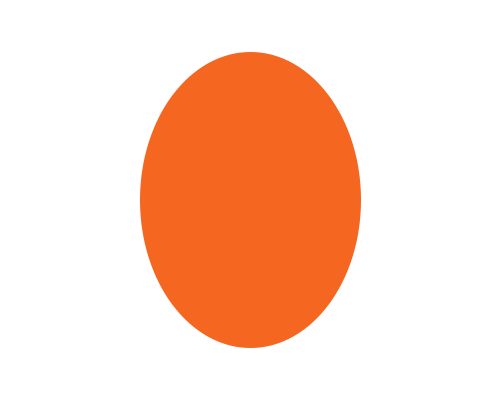 An oval is a two-dimensional shape that is similar to a circle, but elongated in one direction. It has a curved outline, with no straight sides or corners, and two equal and opposite axes of symmetry.
An oval is a two-dimensional shape that is similar to a circle, but elongated in one direction. It has a curved outline, with no straight sides or corners, and two equal and opposite axes of symmetry.
- Pentagon
 A pentagon is a five-sided polygon with five angles that add up to 540 degrees. It is a type of irregular polygon, where each side may have a different length and each angle may have a different measure.
A pentagon is a five-sided polygon with five angles that add up to 540 degrees. It is a type of irregular polygon, where each side may have a different length and each angle may have a different measure.
- Hexagon
 A hexagon is a six-sided polygon with six angles that add up to 720 degrees. It is a type of regular polygon, where all six sides have the same length and all six angles have the same measure (120 degrees).
A hexagon is a six-sided polygon with six angles that add up to 720 degrees. It is a type of regular polygon, where all six sides have the same length and all six angles have the same measure (120 degrees).
- Heptagon
 A heptagon is a seven-sided polygon with seven angles that add up to 900 degrees. It is a type of irregular polygon, where each side may have a different length and each angle may have a different measure.
A heptagon is a seven-sided polygon with seven angles that add up to 900 degrees. It is a type of irregular polygon, where each side may have a different length and each angle may have a different measure.
- Octagon
 An octagon is an eight-sided polygon with eight angles that add up to 1080 degrees. It is a type of regular polygon, where all eight sides have the same length and all eight angles have the same measure (135 degrees).
An octagon is an eight-sided polygon with eight angles that add up to 1080 degrees. It is a type of regular polygon, where all eight sides have the same length and all eight angles have the same measure (135 degrees).
- Nonagon
 A polygon with nine sides is called a nonagon, and it has nine internal angles with a total sum of 1260 degrees. It is a type of irregular polygon, where each side may have a different length and each angle may have a different measure.
A polygon with nine sides is called a nonagon, and it has nine internal angles with a total sum of 1260 degrees. It is a type of irregular polygon, where each side may have a different length and each angle may have a different measure.
- Decagon
 A decagon is a ten-sided polygon with ten angles that add up to 1440 degrees. It is a type of regular polygon, where all ten sides have the same length and all ten angles have the same measure (144 degrees).
A decagon is a ten-sided polygon with ten angles that add up to 1440 degrees. It is a type of regular polygon, where all ten sides have the same length and all ten angles have the same measure (144 degrees).
- Sphere
 A sphere is a 3D object with a perfectly round shape. It consists of all points in space that are equidistant from a fixed point, known as the center. The surface of a sphere is called a spherical surface, and its properties are studied in geometry and math.
A sphere is a 3D object with a perfectly round shape. It consists of all points in space that are equidistant from a fixed point, known as the center. The surface of a sphere is called a spherical surface, and its properties are studied in geometry and math.
- Cube
 A cube is a geometric solid with six square faces, twelve edges, and eight vertices. It is a regular solid object, which means that all its faces, edges, and vertices are equal in size and shape.
A cube is a geometric solid with six square faces, twelve edges, and eight vertices. It is a regular solid object, which means that all its faces, edges, and vertices are equal in size and shape.
- Cone
 A cone is a three-dimensional geometric shape that has a circular base and a curved surface that narrows gradually and smoothly towards a point, which is called the apex. It is a geometric shape that is used to model real-world objects such as ice cream cones and traffic cones.
A cone is a three-dimensional geometric shape that has a circular base and a curved surface that narrows gradually and smoothly towards a point, which is called the apex. It is a geometric shape that is used to model real-world objects such as ice cream cones and traffic cones.
- Cuboid
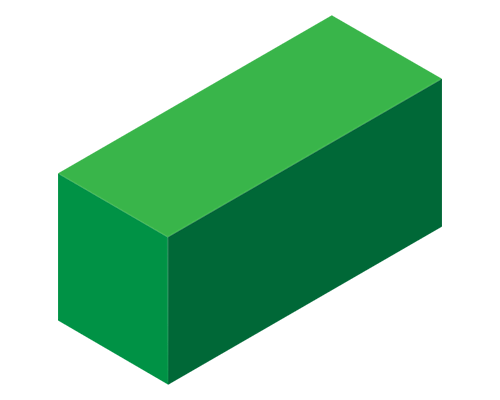 A cuboid is a three-dimensional solid shape that is characterized by six rectangular faces, each of which meets at right angles. It is also called a rectangular prism. A cuboid is used to model real-world objects such as shoeboxes, books, and television sets.
A cuboid is a three-dimensional solid shape that is characterized by six rectangular faces, each of which meets at right angles. It is also called a rectangular prism. A cuboid is used to model real-world objects such as shoeboxes, books, and television sets.
- Cylinder
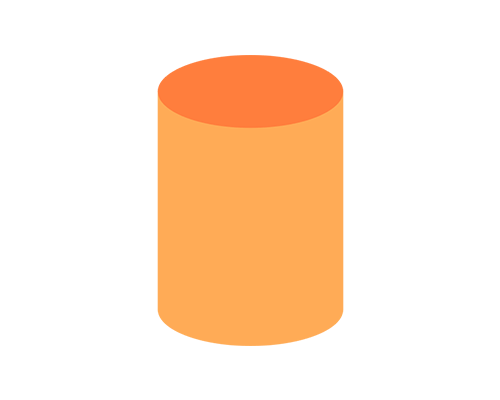 A cylinder is a three-dimensional geometric shape that has two identical circular bases and a curved surface that connects the two bases.
A cylinder is a three-dimensional geometric shape that has two identical circular bases and a curved surface that connects the two bases.
- Pyramid
 A pyramid is a three-dimensional shape with a polygonal base and triangular faces that connect at a central point or vertex. A pyramid takes its name from the shape of its base.
A pyramid is a three-dimensional shape with a polygonal base and triangular faces that connect at a central point or vertex. A pyramid takes its name from the shape of its base.
- Rectangular Prism
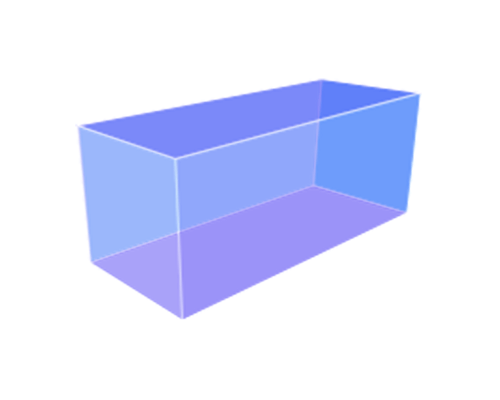 A rectangular prism is a solid geometric shape with six faces, all of which are rectangles. The opposite faces of the rectangular prism are parallel and equal in size. A rectangular prism is also called a rectangular cuboid or a rectangular parallelepiped.
A rectangular prism is a solid geometric shape with six faces, all of which are rectangles. The opposite faces of the rectangular prism are parallel and equal in size. A rectangular prism is also called a rectangular cuboid or a rectangular parallelepiped.
- Trapezoid
 A trapezoid, also known as a trapezium, is a four-sided polygon with two parallel sides and two non-parallel sides. It is a type of quadrilateral that has one pair of opposite sides parallel.
A trapezoid, also known as a trapezium, is a four-sided polygon with two parallel sides and two non-parallel sides. It is a type of quadrilateral that has one pair of opposite sides parallel.
- Parallelogram
 A parallelogram is a four-sided polygon with opposite sides that are parallel and equal in length. Its opposite sides have the same length and are parallel to each other.
A parallelogram is a four-sided polygon with opposite sides that are parallel and equal in length. Its opposite sides have the same length and are parallel to each other.
- Kite
 A kite is a quadrilateral shape that has two pairs of adjacent sides that are equal in length. It has one pair of opposite angles that are equal in measure. The other pair of opposite angles are also equal but not necessarily the same measure as the first pair.
A kite is a quadrilateral shape that has two pairs of adjacent sides that are equal in length. It has one pair of opposite angles that are equal in measure. The other pair of opposite angles are also equal but not necessarily the same measure as the first pair.
- Arrow
 An arrow is a graphical symbol that consists of a straight line with a pointed end, called an arrowhead. Arrows are commonly used to indicate direction or point to a specific object or location.
An arrow is a graphical symbol that consists of a straight line with a pointed end, called an arrowhead. Arrows are commonly used to indicate direction or point to a specific object or location.
- Crescent
 A crescent is a curved, moon-shaped object that appears in the sky during certain phases of the moon.
A crescent is a curved, moon-shaped object that appears in the sky during certain phases of the moon.
- Cross
 A cross is a geometric shape consisting of two perpendicular lines intersecting each other.
A cross is a geometric shape consisting of two perpendicular lines intersecting each other.
- Quadrilateral
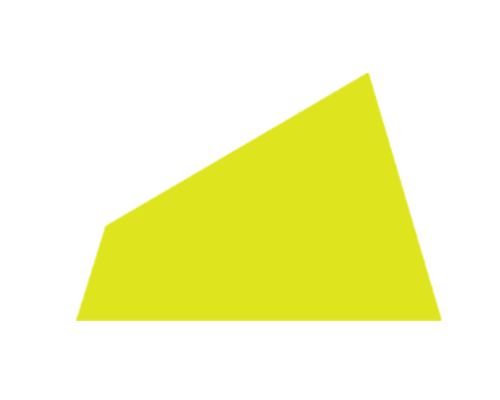 A quadrilateral is a two-dimensional geometric shape that has four sides, four vertices, and four angles. The total of the angles inside it always adds up to 360 degrees.
A quadrilateral is a two-dimensional geometric shape that has four sides, four vertices, and four angles. The total of the angles inside it always adds up to 360 degrees.
- Rhombus
 A rhombus is a four-sided geometric shape with equal sides and opposite angles that are equal to each other.
A rhombus is a four-sided geometric shape with equal sides and opposite angles that are equal to each other.
- Right Triangle
 A triangle with one angle measuring 90 degrees is known as a right triangle. The side opposite the right angle is the longest side, known as the hypotenuse.
A triangle with one angle measuring 90 degrees is known as a right triangle. The side opposite the right angle is the longest side, known as the hypotenuse.
- Ring
 A ring is a geometric shape that resembles a circular band. It has a round shape with a hollow center and is formed by two concentric circles.
A ring is a geometric shape that resembles a circular band. It has a round shape with a hollow center and is formed by two concentric circles.
- Semicircle
 A semicircle is a two-dimensional geometric shape that is formed by cutting a circle into two equal parts along a diameter, resulting in a half-circle.
A semicircle is a two-dimensional geometric shape that is formed by cutting a circle into two equal parts along a diameter, resulting in a half-circle.
- Star
 A star is a geometric shape made up of several lines connecting to form a symmetrical pattern.
A star is a geometric shape made up of several lines connecting to form a symmetrical pattern.
- Trapezium
 A trapezium is a four-sided, flat, geometric shape with two sides parallel and two sides non-parallel. It is also known as a trapezoid in some regions.
A trapezium is a four-sided, flat, geometric shape with two sides parallel and two sides non-parallel. It is also known as a trapezoid in some regions.
- Diamond
 A diamond is a colorless and brilliantly bright mineral that has a crystalline structure and is the hardest naturally occurring substance. It is a solid compound made up of crystalline carbon.
A diamond is a colorless and brilliantly bright mineral that has a crystalline structure and is the hardest naturally occurring substance. It is a solid compound made up of crystalline carbon.
- Hemisphere
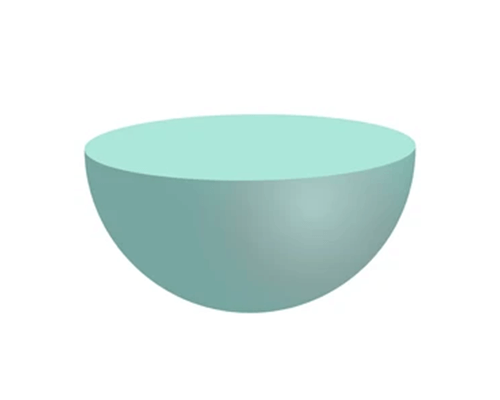 A hemisphere is a three-dimensional geometric shape that resembles half of a sphere, with a curved surface and a flat circular base.
A hemisphere is a three-dimensional geometric shape that resembles half of a sphere, with a curved surface and a flat circular base.
- Hexagonal Pyramid
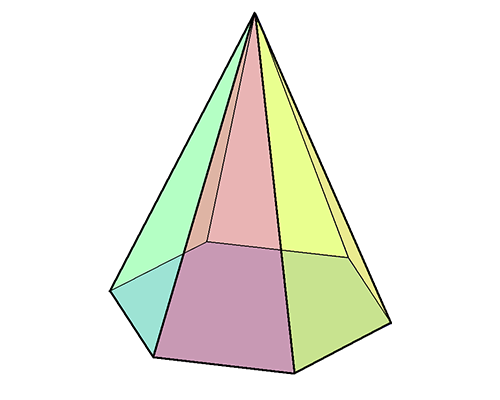 A hexagonal pyramid is a polyhedron with a hexagonal base and six triangular faces that meet at a single point above the base called the apex.
A hexagonal pyramid is a polyhedron with a hexagonal base and six triangular faces that meet at a single point above the base called the apex.
- Octahedron
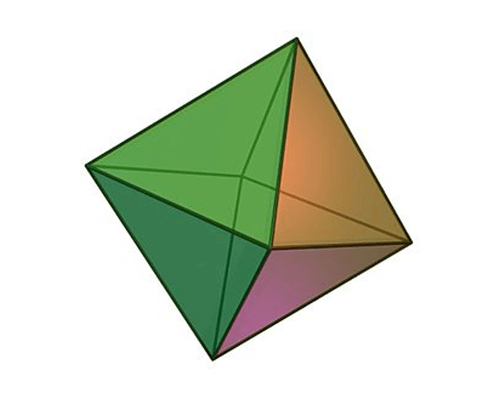 An octahedron is a polyhedron with eight faces, each of which is an equilateral triangle. It has 6 vertices and 12 edges.
An octahedron is a polyhedron with eight faces, each of which is an equilateral triangle. It has 6 vertices and 12 edges.
- Tetrahedron
 A tetrahedron is a geometric solid made up of four triangular faces. At each vertex, three of the triangular faces meet. It is the simplest type of polyhedron, with each face being an equilateral triangle.
A tetrahedron is a geometric solid made up of four triangular faces. At each vertex, three of the triangular faces meet. It is the simplest type of polyhedron, with each face being an equilateral triangle.
- Minus
 Minus is a mathematical symbol that represents subtraction, or taking away one number from another. It is commonly symbolized by the hyphen (-).
Minus is a mathematical symbol that represents subtraction, or taking away one number from another. It is commonly symbolized by the hyphen (-).
- Plus
 Plus sign (+) is a mathematical symbol used to indicate addition, representing the operation of combining two or more quantities or values. It is commonly used in arithmetic and algebra to represent the sum of numbers or variables.
Plus sign (+) is a mathematical symbol used to indicate addition, representing the operation of combining two or more quantities or values. It is commonly used in arithmetic and algebra to represent the sum of numbers or variables.
- Multiplication
 Multiplication is a basic arithmetic operation performed to determine the total value of several equal-sized groups or to find the product of two numbers. It is represented by an asterisk (*) or the letter "x."
Multiplication is a basic arithmetic operation performed to determine the total value of several equal-sized groups or to find the product of two numbers. It is represented by an asterisk (*) or the letter "x."
- Ellipse
 An ellipse is a closed curve in a plane, resembling a stretched-out circle, with two main axes of symmetry intersecting at its center.
An ellipse is a closed curve in a plane, resembling a stretched-out circle, with two main axes of symmetry intersecting at its center.
- Trefoil
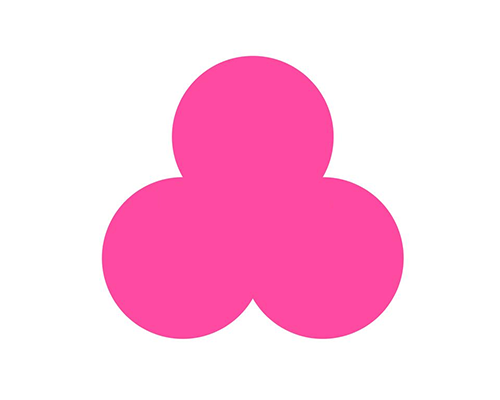 A trefoil is a shape that is composed of three overlapping loops. It is a common design element in various fields, including art, architecture, and nature. In mathematics, it is used to represent knots with three crossings.
A trefoil is a shape that is composed of three overlapping loops. It is a common design element in various fields, including art, architecture, and nature. In mathematics, it is used to represent knots with three crossings.
- Scalene Triangle
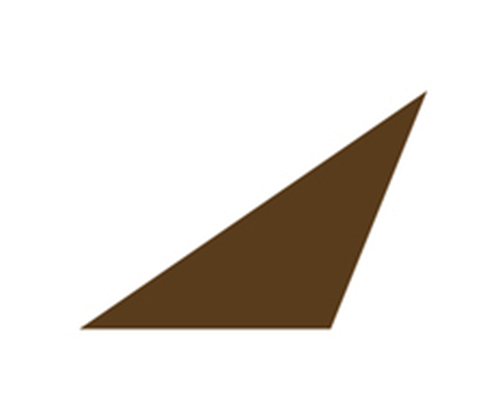 A scalene triangle is a polygon with three sides of varying lengths and three angles of different measures. It is a type of irregular triangle that does not have any sides or angles that are equal
A scalene triangle is a polygon with three sides of varying lengths and three angles of different measures. It is a type of irregular triangle that does not have any sides or angles that are equal
- Isosceles Trapezoid
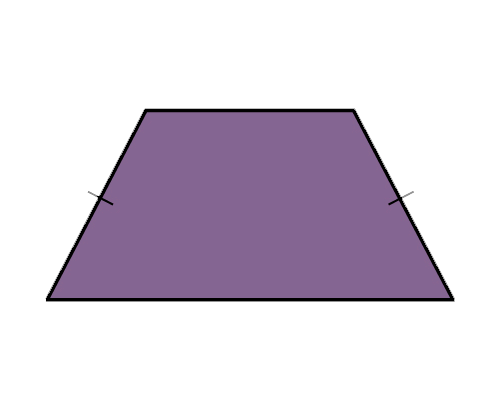 An isosceles triangle is a three-sided polygon with two equal-length sides and two equal angles opposite those sides. It has two pairs of congruent angles and one pair of parallel lines.
An isosceles triangle is a three-sided polygon with two equal-length sides and two equal angles opposite those sides. It has two pairs of congruent angles and one pair of parallel lines.
- Isosceles Triangle
 An isosceles triangle is a triangle with two sides of the same length and two angles opposite those sides that have the same measure. The third side, commonly referred to as the base, usually has a distinct length.
An isosceles triangle is a triangle with two sides of the same length and two angles opposite those sides that have the same measure. The third side, commonly referred to as the base, usually has a distinct length.
- Equilateral Triangle
 An equilateral triangle is a triangle in which all three sides are of equal length and all three angles are of equal measure, specifically 60 degrees. It is a regular polygon and one of the simplest geometric shapes.
An equilateral triangle is a triangle in which all three sides are of equal length and all three angles are of equal measure, specifically 60 degrees. It is a regular polygon and one of the simplest geometric shapes.
- Obtuse Triangle
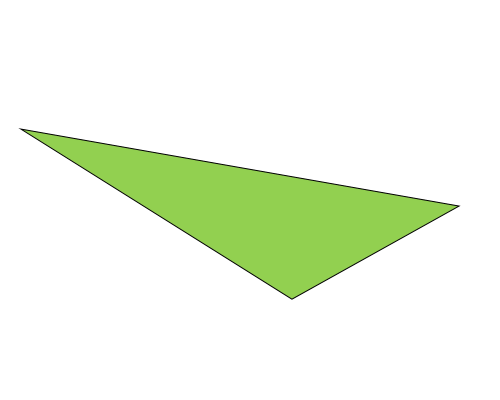 An obtuse triangle is a triangle with an angle greater than 90 degrees, also known as an obtuse angle. This type of triangle has two acute angles and one obtuse angle.
An obtuse triangle is a triangle with an angle greater than 90 degrees, also known as an obtuse angle. This type of triangle has two acute angles and one obtuse angle.
- Acute Triangle
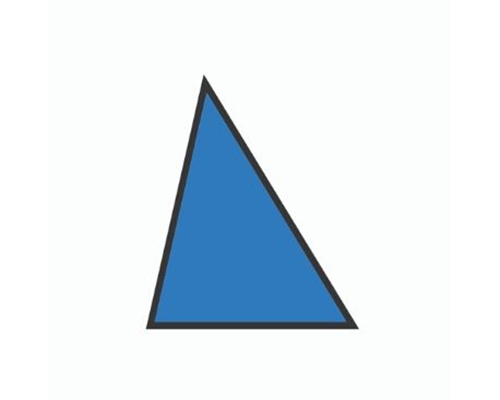 An acute triangle is a type of triangle where all three of its angles are acute angles, which means they measure less than 90 degrees. In other words, an acute triangle is a triangle with three acute angles.
An acute triangle is a type of triangle where all three of its angles are acute angles, which means they measure less than 90 degrees. In other words, an acute triangle is a triangle with three acute angles.
- Pentagram
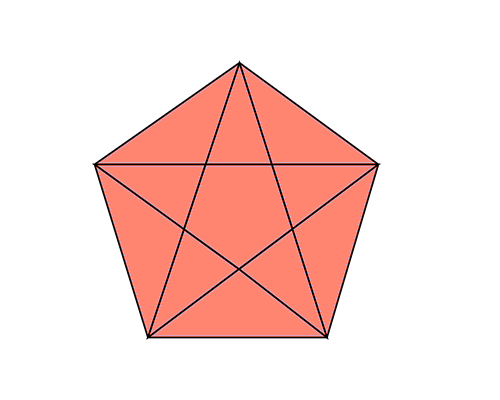 A pentagram is created by connecting five straight line segments in a continuous manner, resulting in a five-pointed star shape.
A pentagram is created by connecting five straight line segments in a continuous manner, resulting in a five-pointed star shape.
- Hexagram
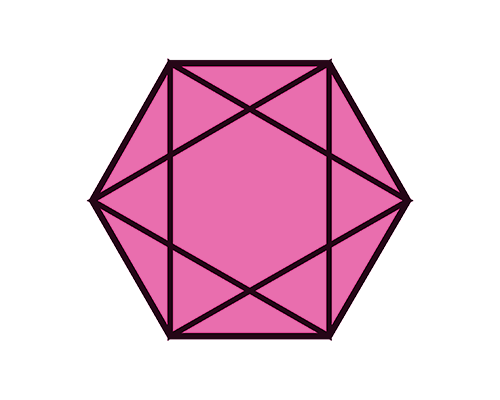 A hexagram is a six-pointed star, formed by two overlapping equilateral triangles.
A hexagram is a six-pointed star, formed by two overlapping equilateral triangles.
- Octagram
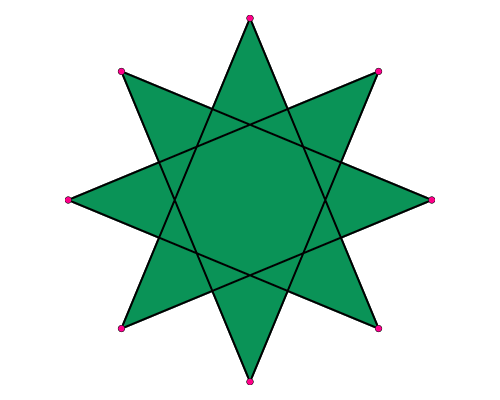 An octagram is a geometric figure consisting of an eight-pointed star formed by two squares that intersect at a 45-degree angle. It is also known as an eight-pointed star or an octangle.
An octagram is a geometric figure consisting of an eight-pointed star formed by two squares that intersect at a 45-degree angle. It is also known as an eight-pointed star or an octangle.
- Parabola
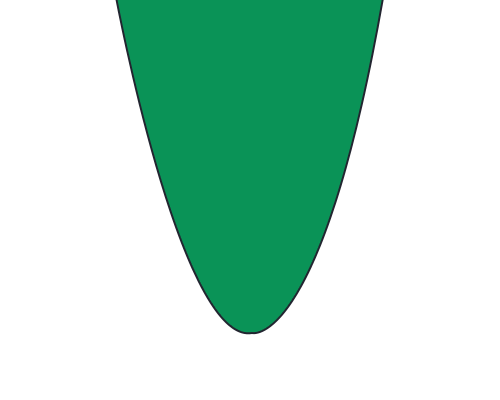 A parabola is a type of curved shape that results from cutting a cone by a plane that is parallel to one of its sides. It has a line of symmetry, called the axis of symmetry, which passes through the focus and the vertex.
A parabola is a type of curved shape that results from cutting a cone by a plane that is parallel to one of its sides. It has a line of symmetry, called the axis of symmetry, which passes through the focus and the vertex.
- Hyperbola
 A hyperbola is a type of conic section formed by the intersection of a plane with two separate but symmetrical cones. It is characterized by a curve that resembles two mirrored U-shapes opening in opposite directions.
A hyperbola is a type of conic section formed by the intersection of a plane with two separate but symmetrical cones. It is characterized by a curve that resembles two mirrored U-shapes opening in opposite directions.
- Dodecahedron
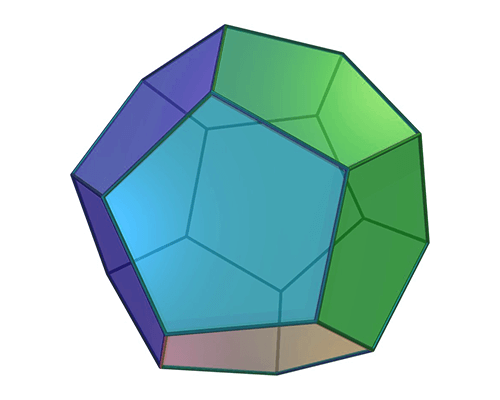 A dodecahedron is a polyhedron with twelve pentagonal faces, thirty edges, and twenty vertices in three dimensions. It is a regular polyhedron, meaning that all of its faces are congruent regular pentagons and all of its angles and edges have the same length.
A dodecahedron is a polyhedron with twelve pentagonal faces, thirty edges, and twenty vertices in three dimensions. It is a regular polyhedron, meaning that all of its faces are congruent regular pentagons and all of its angles and edges have the same length.
- Icosahedron
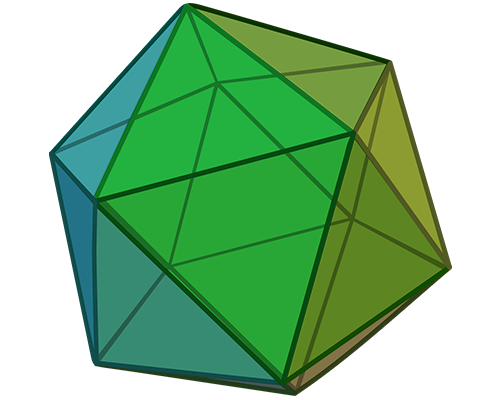 An icosahedron is a three-dimensional solid shape with 20 faces. It has 12 vertices, 30 edges, and each face of this three-dimensional shape is an equilateral triangle. It is a regular polyhedron, meaning that all its faces are congruent and all its edges have the same length.
An icosahedron is a three-dimensional solid shape with 20 faces. It has 12 vertices, 30 edges, and each face of this three-dimensional shape is an equilateral triangle. It is a regular polyhedron, meaning that all its faces are congruent and all its edges have the same length.
- Tetrahedron
 A tetrahedron is a three-dimensional geometric shape made up of four triangular faces, four vertices, and six edges. It is one of the five Platonic solids and has the fewest number of faces.
A tetrahedron is a three-dimensional geometric shape made up of four triangular faces, four vertices, and six edges. It is one of the five Platonic solids and has the fewest number of faces.
- Rhombicuboctahedron
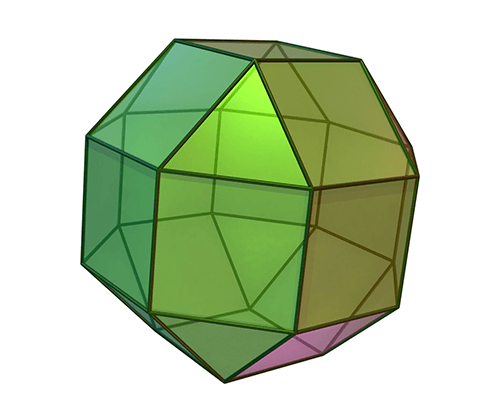 A rhombicuboctahedron is a polyhedron with 26 faces, consisting of 18 square faces and 8 triangular faces. The shape has a total of 24 vertices and 48 edges.
A rhombicuboctahedron is a polyhedron with 26 faces, consisting of 18 square faces and 8 triangular faces. The shape has a total of 24 vertices and 48 edges.
Conclusion:
In conclusion, understanding the different shapes and their properties is an important aspect of mathematics, science, engineering, and design. This comprehensive guide has covered 55+ shapes, ranging from basic geometric shapes to more complex ones. At Ekya Schools, we believe in providing the best education to our students, which includes a thorough understanding of shapes and geometry. By providing a picture-perfect guide to shapes, we hope to inspire students to explore and appreciate the beauty and complexity of the world around them. As one of the best kindergarten schools in Bangalore, Ekya Schools strives to provide its students with the best education possible and this guide is just one of the many resources we offer to achieve that goal.Number Names From 1 to 100 for Kids in English
As parents, we all want our children to grow up knowledgeable and intelligent. This starts with providing them with a solid foundation in their early years, especially when it comes to education. One of the most fundamental aspects of early education is learning numbers and counting.
In this blog, we will discuss the importance of teaching your kids number names and providing tips and resources to make the process easier.
Why is it Important to Teach Number Names for Kids?
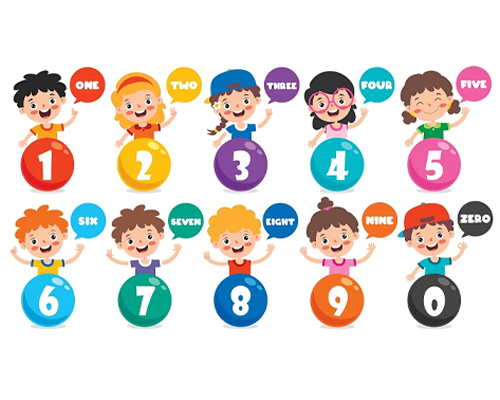
Number names are the words that we use to represent numerical values. For example, one, two, three, and so on. Teaching kids number names is important for several reasons:
Better Understanding of Numbers: When children learn the number names, they can better understand the value of numbers. For example, they will know that "ten" represents the value of 10, and "twenty" represents the value of 20.
Improved Counting Skills: When children learn number names, it helps them count more accurately and efficiently.
Preparing for Mathematical Concepts: Number names lay the foundation for more complex mathematical concepts that children will learn in the future, such as addition and subtraction.
Communication Skills: Learning number names is an important aspect of language development. It helps children to communicate about quantities and express themselves mathematically.
Know More
Click here to find out 56 Names of Shapes with Pictures
How to teach kids number names?

Teaching number names to kids can be a fun and engaging experience for both children and parents. Below are a few suggestions that can aid in simplifying the process:
Use Visual Aids: Using visual aids like flashcards or charts can be a helpful way to teach number names to children.
Sing Songs and Rhymes: Children love music, and singing songs and rhymes that involve number names can be a fun and effective way to help them learn.
Play Games: Games like "I Spy" or "What Comes Next?" Engaging children while teaching them number names can be an enjoyable approach.
Use Everyday Experiences: Incorporating number names into everyday experiences like counting toys or snacks can help children learn practically and meaningfully.
Also Read:
- 56 Names of Shapes with Pictures
- The Top 50 Free Educational Websites For Kids In (2023)
- Which is the best Educational Board for the Future: CBSE: ICSE : IGCSE?
- Why Knowing Inch To CM Conversion Is Important
Explore the range of Numbers from 1 to 100 along with their corresponding Number Names
Discover the English number names from 1 to 100 and empower children to convert names into numbers. Join us on an exciting journey of numerical exploration and language development.
| 1 = One | 2 = Two | 3 = Three | 4 = Four | 5 = Five |
| 6 = Six | 7 = Seven | 8 = Eight | 9 = Nine | 10 = Ten |
| 11 = Eleven | 12 = Twelve | 13 = Thirteen | 14 = Fourteen | 15 = Fifteen |
| 16 = Sixteen | 17 = Seventeen | 18 = Eighteen | 19 = Nineteen | 20 = Twenty |
| 21 = Twenty-one | 22 = Twenty-two | 23 = Twenty-three | 24 = Twenty-four | 25 = Twenty-five |
| 26 = Twenty-six | 27 = Twenty-seven | 28 = Twenty-eight | 29 = Twenty-nine | 30 = Thirty |
| 31 = Thirty-one | 32 = Thirty-two | 33 = Thirty-three | 34 = Thirty-four | 35 = Thirty-five |
| 36 = Thirty-six | 37 = Thirty-seven | 38 = Thirty-eight | 39 = Thirty-nine | 40 = Forty |
| 41 = Forty-one | 42 = Forty-two | 43 = Forty-three | 44 = Forty-four | 45 = Forty-five |
| 46 = Forty-six | 47 = Forty-seven | 48 = Forty-eight | 49 = Forty-nine | 50 = Fifty |
| 51 = Fifty-one | 52 = Fifty-two | 53 = Fifty-three | 54 = Fifty-four | 55 = Fifty-five |
| 56 = Fifty-six | 57 = Fifty-seven | 58 = Fifty-eight | 59 = Fifty-nine | 60 = Sixty |
| 61 = Sixty-one | 62 = Sixty-two | 63 = Sixty-three | 64 = Sixty-four | 65 = Sixty-five |
| 66 = Sixty-six | 67 = Sixty-seven | 68 = Sixty-eight | 69 = Sixty-nine | 70 = Seventy |
| 71 = Seventy-one | 72 = Seventy-two | 73 = Seventy-three | 74 = Seventy-four | 75 = Seventy-five |
| 76 = Seventy-six | 77 = Seventy-seven | 78 = Seventy-eight | 79 = Seventy-nine | 80 = Eighty |
| 81 = Eighty-one | 82 = Eighty-two | 83 = Eighty-three | 84 = Eighty-four | 85 = Eighty-five |
| 86 = Eighty-six | 87 = Eighty-seven | 88 = Eighty-eight | 89 = Eighty-nine | 90 = Ninety |
| 91 = Ninety-one | 92 = Ninety-two | 93 = Ninety-three | 94 = Ninety-four | 95 = Ninety-five |
| 96 = Ninety- six | 97 = Ninety-seven | 98 = Ninety-eight | 99 = Ninety-nine | 100 = Hundred |
Discover a comprehensive list of mathematical number names and ordinal number names from 1 to 20.
Enhance your mathematical vocabulary and understanding of ordinal numbers with this valuable resource.
| Number (in Digits) | Maths Number Names | Ordinal Number Names |
| 1 | One | First |
| 2 | Two | Second |
| 3 | Three | Third |
| 4 | Four | Fourth |
| 5 | Five | Fifth |
| 6 | Six | Sixth |
| 7 | Seven | Seventh |
| 8 | Eight | Eighth |
| 9 | Nine | Ninth |
| 10 | Ten | Tenth |
| 11 | Eleven | Eleventh |
| 12 | Twelve | Twelfth |
| 13 | Thirteen | Thirteenth |
| 14 | Fourteen | Fourteenth |
| 15 | Fifteen | Fifteenth |
| 16 | Sixteen | Sixteenth |
| 17 | Seventeen | Seventeenth |
| 18 | Eighteen | Eighteenth |
| 19 | Nineteen | Nineteenth |
| 20 | Twenty | Twentieth |
Resources to help teach kids number names

There are many resources available to help teach kids number names, including:
Books: There are many books available that focus on teaching number names to children, such as "One Fish, Two Fish, Red Fish, Blue Fish" by Dr. Seuss.
Know More
Click here to find out Top 50 Free Educational Websites For Kids In (2023)
Online Resources: There are numerous online resources available to help teach number names to children, including videos and interactive games.
Educational Apps: There are many educational apps available that focus on teaching number names to children, such as "Endless Numbers" and "Todo Math".
Ekya Schools: The Perfect Place to Teach Your Kids Number Names
If you are looking for a school that prioritises early education and provides a solid foundation for your child's future, Ekya Schools is an excellent choice. Ekya Schools is a group of Montessori and kindergarten schools in Bangalore that focuses on providing quality education for children in their early years.
Ekya Schools use a unique approach to early education that focuses on experiential learning, which involves learning through hands-on experiences and real-life situations. This approach is highly effective for teaching children number names, as it allows them to learn in a practical and meaningful way.
Conclusion
Teaching kids number name is an essential aspect of early education. By using fun and engaging teaching methods and resources, parents can help their children to learn number names more easily and effectively. Ekya Schools provides an excellent environment for children to learn number names and other important concepts in their early years.










Leave a reply